The Boomerang (Burt's Favorite Creation) And The Oregon Aero Custom Interior (12 Pix)
 Monday, May 19, 2014 at 10:45AM
Monday, May 19, 2014 at 10:45AM  (click pic for hi-res) The Boomerang: nearly ready to fly at Mojave in 1996
(click pic for hi-res) The Boomerang: nearly ready to fly at Mojave in 1996
Burt’s favorite creation:
When world-famous aircraft designer Burt Rutan completed the Boomerang in 1996, the design looked wildly unusual, even for one from a designer who was well known for shattering conventional thought. But while aircraft from Burt like the VariViggen (his first design) and the Long-EZ (his most popular) and SpaceShipOne (his most widely known) were all very different than what we used to seeing, they all were at least symmetrical designs... meaning, if you cut them in half down the middle, the left and right sides had the same shape. But with the Boomerang, even deciding where the middle was might leave you confused! And once you decided where you were going make that cut, you sure weren’t going to get a left and a right that looked anything alike.
Interestingly, it was a desire to create a design that ‘flew’ symmetrically that gave the Boomerang such an unusual look. Burt wanted to create an efficient twin engine aircraft that flew nearly as well with an engine out as it did with both running, and would do so regardless of which engine was no longer running. Traditional twin-engine aircraft with an engine on each wing can be very difficult to fly safely on just one engine. Push/pull centerline thrust designs had addressed this in the past, but mounting an engine on either end of the passenger cabin doesn’t create the most comfortable environment to spend 3 to 6 hours. So, using his out-of-the-box creativity and strong engineering skills, Burt designed one of the most unusual airplanes we’ve ever seen. In the process he created his own personal favorite aircraft, and one that accomplished his very safe flying qualities on one engine goal.
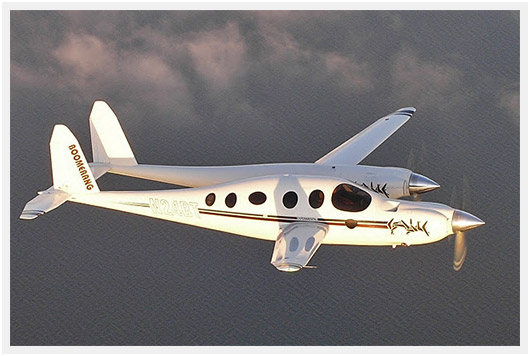 One of the world's most unusual airplanes: Burt Rutan's Boomerang
One of the world's most unusual airplanes: Burt Rutan's Boomerang
The Boomerang is built largely of carbon fiber and is pressurized to 4.6 psi. The engines are Lycoming TIO-360’s with the one on the main fuselage making 210hp and the one on the boom making 200hp. It carries about 170 gallons of fuel which gives the potential for economy cruise at 24,000 feet of 240 mph for up to 10 hours making a range of about 2,400 miles! There are five seats total, with the three seats in the back providing excellent stretch-out leg room.
Restoration:
Burt flew the Boomerang for several years as his personal aircraft, but some heart surgeries in 2002 changed his ability to fly and the Boomerang was parked. When Burt retired from Scaled Composites in 2010 he was looking for something good to do with the Boomerang, a way for its existence to have an impact on the future. Putting it in a museum would have some affect on the future, but if the airplane was restored to flying condition (from having sat parked for several years) its impact could be far greater. That’s where Tres Clements comes into the picture. Tres is an engineer at Scaled Composites who just happened to be in the right place at the right time to answer ’yes’ to Burt when he asked if Tres wanted the Boomerang. By becoming the leader of a group of people to restore the Boomerang and then fly it as well, Tres could give Burt’s favorite baby the care it needed while helping the world stay in contact with one of the most interesting aircraft ever built.
 The Boomerang during restoration by Tres Clements and crew at Mojave
The Boomerang during restoration by Tres Clements and crew at Mojave
Interior by Oregon Aero:
You might already know that the Boomerang was a big hit at Oshkosh 2011 when Tres brought it out from California for its first public exposure in over 10 years. Thousands of people looked the airplane over closely with the opportunity to walk right up to it and even see inside with the unique cockpit windshield plug door being open along with the right side fold-down step/door open much of the time as well. If you happened to be there, then like me, you probably noticed that while the outside of the Boomerang was nicely painted and looked great for a 15 year old prototype, the inside looked like an experimental spaceship that didn’t care if you were comfortable or not. This is where Oregon Aero from Scappoose, Oregon comes into the picture. In late 2011, Tres flew the Boomerang up to Scappoose to have Oregon Aero install a complete custom-built interior system in the Boomerang… for the first time since its completion in 1996, the Boomerang was going to be a complete aircraft. (see Boomerang pix before the interior installation at the bottom of this post)
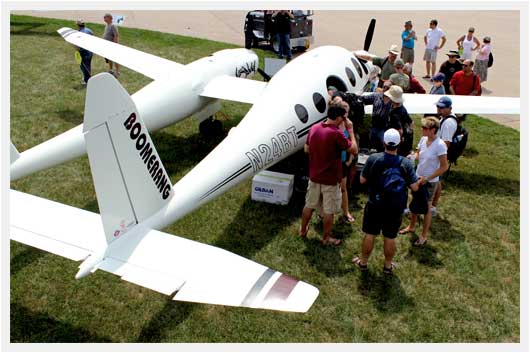 The Boomerang at OSH11 attracting attention before the week had even started
The Boomerang at OSH11 attracting attention before the week had even started
Oregon Aero was started in 1989 by Mike Dennis and his wife Jude to help people fly pain-free by engineering and manufacturing comfortable, safer and quieter products that meet a wide range of customer needs. What started with just one product designed to make headsets more comfortable has grown into a company that offers various headset and helmet comfort products, as well as being a premier supplier of enhanced-comfort and improved-safety seat cushions and seating systems. And, as is shown by the stunning custom work accomplished on the Boomerang, Oregon Aero is an expert at producing interiors for production aircraft, or even one-of-a-kind homebuilts. They’ve reached a level of expertise that they are a significant supplier of enhanced-comfort/low-fatigue ejection seat cushions for U.S. military aircraft like the F-22 Raptor. They are also a supplier of helmet liners, ear seals, and microphone covers for military aircraft, including the F-22.
Customers wanting an Oregon Aero interior can bring their aircraft to their facilities on the Scappoose Industrial Airpark (KSPB) just north of Portland, or for many interior projects you can ship your interior to them for upgrade. They have customers from all across the country who get seat upgrades or entire interior upgrades without ever having their airplane leave home. And their facilities and staff are up to the challenge of handling whatever aircraft interior need you have. They do work on small aircraft like Cubs and RV-12’s, all the way thru to cabin-class twins.
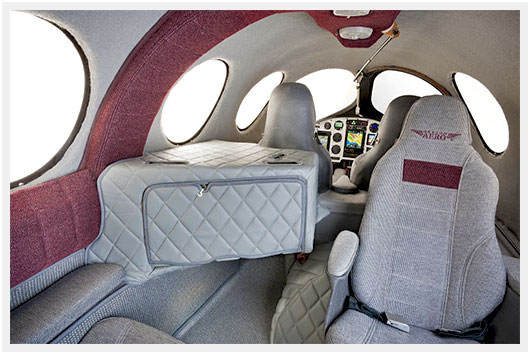 (click pic for hi-res) Gorgeous interior by Oregon Aero in the one-of-a-kind Boomerang
(click pic for hi-res) Gorgeous interior by Oregon Aero in the one-of-a-kind Boomerang
On the Boomerang project, Oregon Aero was given the task of designing, building, and installing the one-of-a-kind interior. If you’re like me, when you first see the pictures of the completed Boomerang interior you probably think that looks really nice, but I’m really more interested in the way this wildly unusual aircraft looks and flies. That’s understandable, but taking time to realize what a huge task building a custom interior for this challenging aircraft was will really help you understand how uniquely qualified Oregon Aero is to help anyone with any aircraft interior project they have, now or in the future.
The Oregon Aero capabilities are better understood when you realize that the Boomerang fuselage doesn’t have a straight line in it anywhere. With compound curves and lots of unique challenges all over the cabin, a project like this really stretches the talents of the craftsmen. As you can well imagine, installing a one-of-a-kind headliner in such an unusual fuselage is a huge task in itself. All the windows are oval and there are several different shapes and sizes...and there’s no symmetry between the window layout on the left and right. The Boomerang presents some of the most challenging interior design work imaginable!
 The Boomerang is transformed into an extremely comfortable ride for 5
The Boomerang is transformed into an extremely comfortable ride for 5
But making the cabin look nice is never the limit of the goal for Oregon Aero… making it more comfortable and even safer is just as important. Seat cushions are hand sculpted out of memory foam to give the kind of comfort you just can’t get with flat foam. This sculpting not only enhances comfort by reducing fatigue in the seat, but it also puts your body into a more ergonomically correct position which can have a dramatic effect on reducing injuries sustained in very hard landings. Plus memory is better at absorbing impact energy. Sure, nobody plans to experience a very hard landing in their aircraft, but doesn’t it make sense to have an interior system that’s been designed with that in mind in case you ever wind up in that situation?
 (click pic for hi-res) Check out the attention-to-detail in Oregon Aero's work!
(click pic for hi-res) Check out the attention-to-detail in Oregon Aero's work!
As you look at the interior of the Boomerang you’re probably wondering what the large box is on the left side of the cabin. When Burt built the airplane he incorporated the use of a Macintosh PowerBook computer to provide GPS navigation, and to monitor engine and airframe performance. The box in the cabin was used to house various electrical hardware need to make all this work, including the data acquisition box. All of this was years ahead of its time, and while we see these kinds of systems commonly today in very small packages, lots more space was needed for it all in the mid 1990’s. However, when Tres restored the aircraft, he upgraded the electronics to reflect the state of the art today… to embrace what Burt had always hoped his tinkering would lead to. So now, that box is mostly a large and convenient storage space for the passengers in the rear. Of course an unusual cabin component like that box created another unique challenge for the interior project. By the way, there’s a large baggage area in the left boom that will even accept that most rearward seat in case you need to haul something large or long in the main fuselage, or want an area big enough to sleep on. There’s also a smaller glove box located in the instrument panel.
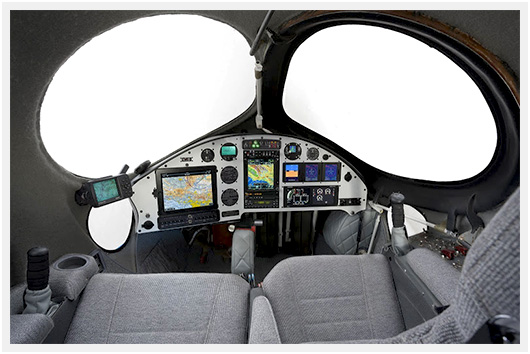
 The Boomerang cockpit with new interior and upgraded avionics
The Boomerang cockpit with new interior and upgraded avionics
Burt Rutan poured 25 years of aircraft design experimentation and innovation into the Boomerang design, and he has said that “it’s the most significant general aviation airplane I’ve ever done”. Thru the work of Tres Clements and his crew, the Boomerang lives on to inspire the future of aircraft design… and Oregon Aero has contributed to the legacy of one of the world’s most unique and interesting aircraft by designing, building, and installing a fabulous custom interior that finally completes the vision of what the Boomerang could be.
Please don’t hesitate to check out the details of what Oregon Aero can do to add comfort and safety to your flying experience by stopping by oregonaero.com, downloading their 91 page catalog .pdf file, or give them a call at 800-888-6910.
The dedicated Oregon Aero team promise:
Provide 100% customer satisfaction. No exceptions. We’re not satisfied until the customer is 100% satisfied.
Practice extraordinary innovation. We think beyond the norm and seek to change the status quo by designing products that surpass industry and marketplace expectations.
Provide optimal product performance. Our products provide the benefits we promise.
Provide the best possible quality in all of our products. Every aspect of design, materials and manufacturing is implemented with the assumption that we will provide the best possible quality to the customer.
Pursue excellence relentlessly. We strive for excellence and continual improvement in all work processes.
Never be deterred by those who say, “It can’t be done!” We have broken and will continue to break the barrier of conventional thinking.
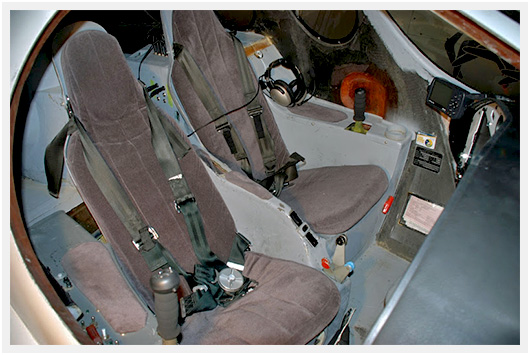
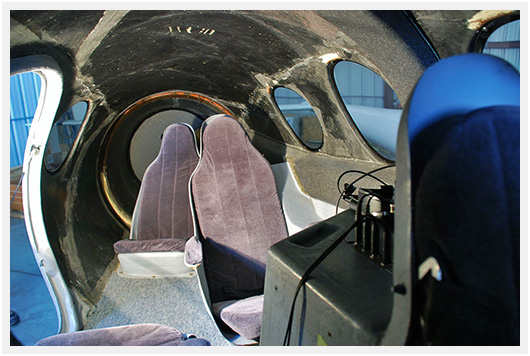
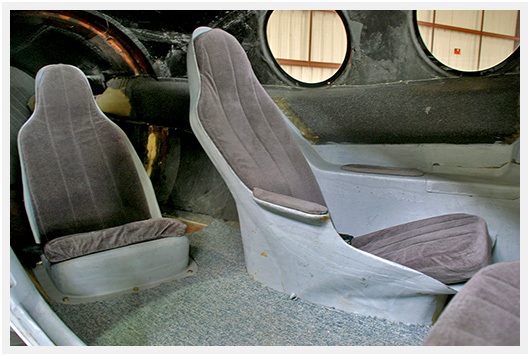
Like this post? Tell your friends... use the 'share' or 'email' article links below - thanx : )














































































Reader Comments (2)
That is awesome!
Full points for originality; if I could give an 11, I would. But I bet flying this would be a nightmare. Permanent differential thrust on the port side and the windows are barely bigger than portholes. Pretty, but would never be in the air with me at the tiller, or in it for that matter.